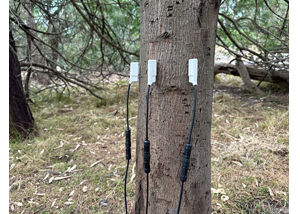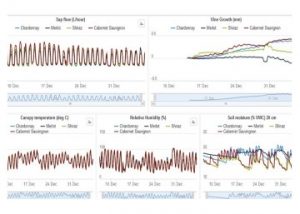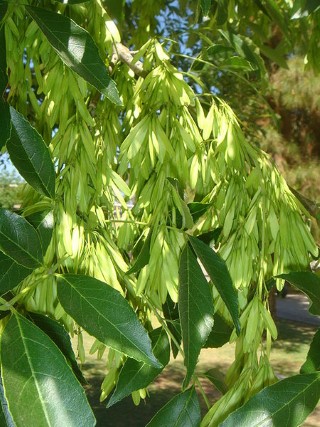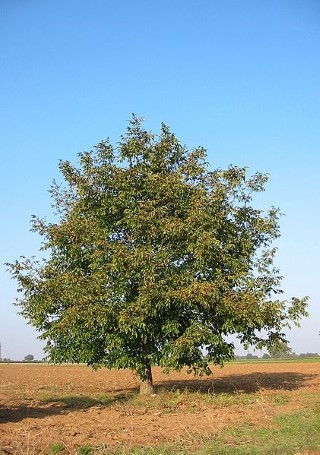sap flow explained....
Sap flow is the movement of fluid in the roots, stems and branches of plants. Sap flow is typically measured in the xylem of plants. More specifically, sap flow is measured in the sapwood portion of xylem, or the conducting wood, which differs to the other portion of xylem known as heartwood.
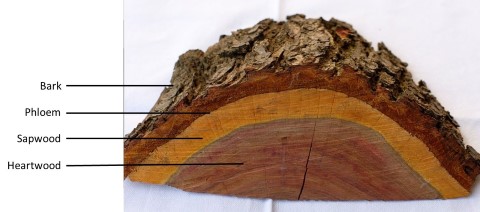
A cross-section of a tree (Prunus spp. / plum) trunk showing various plant tissues. Original image source: WikiCommons with our own edits.
Sap flow is synonymous with water movement in plants. However, it is not referred to as water flow, or water velocity, as the fluid in a plant's stem is not pure water. The fluid contains other elements, such as nutrients and hormones, and therefore it is called sap.
The sap flow in the sapwood should not be confused with the sugary sap in the phloem of plants. When sap flow is measured with a heat pulse velocity sensor, it is the sap movement in the sapwood, or xylem, that is being measured and not the phloem.
Sap flow is also synonymous with transpiration and, occasionally, evapotranspiration (ETo). However, sap flow is not strictly transpiration nor is it evapotranspiration. Sap flow is the movement of fluid within plants whereas transpiration is the loss of water from the plant as water vapour. Evapotranspiration is transpiration plus the evaporation of water from other surfaces, particularly soil. Regardless of these definitions, a measurement of sap flow and estimation of total plant water use is often regarded as a close approximation of transpiration once the appropriate correction factors have been included in any calculation. This is because any upward movement of sap in plants will most likely result in eventual transpiration.
sap flow articles & guides
what is the difference between heat velocity, sap velocity, sap flux and sap flow?
These terms are often used interchangeably when measuring and quantifying plant water use. For an in-depth discussion on sap flow nomenclature see Edwards et al (1997) and Lemeur et al (2009).
Heat velocity - or heat pulse velocity, is the raw unit of measurement for HPV sap flow sensors. It is the rate of movement of a heat pulse, being carried by convection in the sap stream, away from the linear heater. Heat velocity is a useful diagnostic parameter to check the direction of sap movement (positive or reverse), as well as checking for correct installation of sensors - particularly checking for probe misalignment. Corrected heat velocity includes corrections for any probe misalignment (see sensor installation section below) and wounding effects. Heat velocity is often expressed as meters per second (m s-1), or centimeters per hour (cm hr-1).
Sap velocity - the velocity of sap measured at a single point along the HPV sap flow temperature sensor probe. Sap velocity is tree or species specific as it is heat velocity corrected for sapwood density, thermal diffusivity and other wood or thermal related properties. Sap velocity is often expressed as meters per second (m s-1), or centimeters per hour (cm hr-1).
Sap flux - or sap flux density, is a volume of fluid (sap) that is passing, or flowing, across a given area of sapwood per unit of time. Sap flux density is often expressed as cm3 (volume of sap) per cm2 (area of sapwood) per second, minute or hour (time).
Sap flow - is the integration of sap flux across the entire conducting wood, or sapwood, in a tree. Sap flow is often expressed as cm3 per hour, kilogram (kg) per hour, or liters (L) per hour. Sap flow can also be expressed as a volume over a longer course of time such as a day, week, growing season, or calendar year.
what is the difference between heat pulse and continuous heating sap flow sensors?
There are two major classes of sensors used by sap flow scientists: heat pulse and continuous heating. As their names suggest, the main difference between the types of sensors is how heat is applied to the stem. With heat pulse sensors, a short duration pulse between 1 and 8 seconds is applied to the stem. With continuous heating sensors, heat is always applied to the stem.
Familiar methods within the heat pulse sensor family include compensation heat pulse method, T-max method, heat ratio method and sap flow plus method. Familiar methods within the continuous heat sensors include thermal dissipation, or the Granier method, and the stem heat balance method.
Heat pulse velocity methods explained:
Although all methods of sap flow measurement have advantages and limitations, Edaphic Scientific encourages sap flow researchers to use the various heat pulse methods. There are 4 main reasons why we encourage use of the heat pulse method:
- Power Supply - the heat pulse methods use significantly less power than continuous heating methods. Reliable power supply is absolutely critical for any field researcher particularly in remote, inaccessible locations. The heat pulse sensors only require a relatively small solar panel and battery. The continuous heating methods need a significant investment in large solar panels and batteries and even then power supply is not guaranteed.
- Measurement Range - the heat pulse sensors can measure the complete range of sap flow that plants exhibit. The dual heat pulse method, outlined here, can measure reverse, low, positive and extremely rapid rates of sap flow. Continuous heating sensors cannot measure reverse sap flow.
- Accuracy - heat pulse sensors are generally considered to have a sound theoretical basis and many studies have proven their accuracy.
- Multi-point measurements - heat pulse methods are able to have 2 or more temperature measurement points across the radial profile of a tree's xylem. The more sampling points increases the accuracy of sap flow measurements as well as providing physiological insights in plant water relations. The continuous heat methods can only measure one point across the xylem radius, or total bulk sap flow of the entire xylem.
scaling from point measurements to whole-tree, stand and forest scale

Sap flow measurements at the tree level can be scaled to estimated whole-stand and forest water use.
The Implexx Sap Flow Sensor has 2 measurement points along the radial profile of the tree's sapwood. Although these 2 measurement points can provide excellent insights into tree water relations, it is still effectively a single point measurement.
On small trees, a single sap flow sensor may only be required to estimate total tree water use. On larger trees, it may be necessary to have two, three, four or more sap flow sensors installed around the circumference of the tree.
The HPV sap flow sensors are low cost and, therefore, it can be highly practical and within tight funding budgets to measure many points around a tree, and many trees within a stand or forest.
Scaling from a tree measurements to stand, forest and landscape scales requires additional information about species abundance and diversity, stem size class distribution, and possibly other factors. It may be necessary to establish multiple sites within a forest or landscape, or randomly scatter individual sap flow loggers throughout the study area.
Several publications are available that discuss how to extrapolate sap flow measurements from the tree to the stand and larger scales including Hatton and Wu (1995) and Kostner et al (1998).
common applications for sap flow monitoring
plant water relations and plant physiology
Measuring sap flow is a popular technique among plant physiologists and ecohydrologists to precisely quantify plant water use and total daily water use.
Often, sap flow is correlated with other plant physiology variables such as photosynthesis, stomatal conductance and growth.
Sap flow is also correlated with environmental, or abiotic, variables such as solar radiation, vapour pressure deficit and soil moisture.
forestry
The application of sap flow monitoring in forestry is common. Sap flow measurements can be used to assess forest health, total water use, the need for or response to irrigation, species and crop selection, and forest response to drought and climate change.
horticulture and viticulture
Sap flow sensors are commonly installed in orchards and vineyards for scientific research and commercial applications. Sap flow response to irrigation or natural rainfall regimes can be used to determine farm-level water management strategies.
Correlating whole season sap flow with yield or growth can be used to select for different species or crop varieties. Monitoring sap flow at different periods of the growing season, and adjusting irrigation regimes, can improve the quality and quantity of crops.
mining and phytoremediation
Vegetation is either left intact, restored or utilised for some function in and around mining operations. Sap flow sensors can be used to continuously monitor the health of trees and vegetation in mining operations. For phytoremediation, sap flow sensors can be used to determine whether transplanted or afforested areas are healthy or to determine species suitability for growing on soils with high levels of toxins or heavy metals. In hypersaline areas, or with trees that are irrigated with hypersaline water from mining operations, sap flow can be used to monitor total daily flow and whether trees are efficiently removing waste water to the atmosphere.
urban water management
There is often a requirement to more efficiently manage urban stormwater run-off and wastewater. Town planners and local councils are increasingly turning towards trees for urban water management. Sap flow monitoring can determine how much, and when, trees are utilising water resources.
water catchments
Many of our water catchment areas are heavily forested with trees that can transpire potentially tens to hundreds of liters per tree per day. Hydrologists and water catchment managers increasingly need to understand, in precise detail, the water budget of catchment areas. Quantifying sap flow in trees, and scaling the results to a landscape level, can provide data on an important source of water demand in catchment areas.
tree health and disease
Daily maximum sap flow rates decline in trees that are stressed, unhealthy or suffer from disease. Radial monitoring of sap flow around the circumference of the tree trunk can determine whether disease is compartmentalised or prevalent throughout the tree. Alternatively, a once unhealthy tree can be monitored to determine whether management practices are working in bringing that tree back to health.
sap flow scientific research themes
The HPV sap flow sensors we offer are suitable for the following scientific research themes. Note that this list is not exhaustive, but represents some of the more common research fields pursued by sap flow scientists.
Edaphic Scientific can assist you with your scientific project, including experimental design, data interpretation, data analysis, and manuscript preparation. Contact us for more information.
climate change and tolerance to drought and heat waves
Sap flow sensors can increase our understanding of plant water relations in response to climate change, particularly increased temperature, frequency and longevity of heat waves, and drought. Sap flow sensors can be used to directly understand whole-plant water use and stem capacitance and storage in response to moisture deficits.
xylem structure and radial patterns of sap flow
The East 30 Sensors HPV sap flow sensors have 3 measurement points along the temperature needle. These three points can characterise patterns of sap flow in the outer, middle and inner portions of sapwood, and can improve our understanding of vascular transport in plants.
How differential patterns of sap flow across these portions of sapwood varies between species, and in response to environmental variables and ecological interactions, can be studied with sap flow sensors.
How sap movement is similar to, or different from, varying xylem structures can also be studied with sap flow sensors. For example, how is sap flow the same or different across conifers, palms or trees with secondary xylem and what are the evolutionary and ecological consequence of these patterns of variation.
hydraulic redistribution
Traditionally, sap movement in plants has been understood as one of unidirectional ascent from roots, to stem and to leaves. Sap flow sensors can be used to show that sap movement can actually occur in any direction, even from the leaves back down to the roots, and is commonly known as hydraulic redistribution.
nocturnal sap flow
Closely related to the process of hydraulic redistribution is nocturnal, or night-time, sap flow. It is commonly understood that, in most trees, there is no photosynthesis during the night, the stomata close, and therefore there is no transpiration and sap flow.
However, sap flow measurements have shown that, on average, nocturnal sap flow accounts for, on average, 12.4% of total daily sap flow. The causes of nocturnal sap flow, and its prevalence across species, is an ongoing area of research.
groundwater and vadose zone dynamics
Sap flow sensors can be used to understand how trees access groundwater, particularly in drier climates. Zones of soil moisture depletion in the vadose zone, coupled with plant growth and root elongation, can also be understood with sap flow sensors. Groundwater dependent ecosystems (GDE's) can be extensively studied with sap flow sensors.
Sap flow sensors are also extremely useful in quantifying parameters for hydrological modelling. For example, soil-plant-atmosphere continuum models, and the interaction with groundwater, regularly require data from sap flow sensors to verify model parameters.
invasive species and ecosystem functioning
The effects of invasive species and land use change on ecosystem functioning, particularly the hydrological cycle, can be greatly understood with sap flow sensors. A comparison of sap flow dynamics in invasive versus native species, or a plantation versus natural forest, can be measured with HPV sap flow sensors.
example scientific publications
hydraulic redistribution and nocturnal sap flow
Authors: Hultine KR, Williams DG, Burgess SSO, and Keefer TO.
Title: Contrasting patterns of hydraulic redistribution in three desert phreatophytes
Journal: Oecologia
DOI and Weblink:
Summary:
Sap flow was measured in the roots and stems of three co-occurring species in the Chihuahuan desert, Arizona, USA. The species were Fraxinus velutina, Juglans major and Celtis reticulata. Reverse sap flow was found to be high in Fraxinus, low in Juglans and zero in Celtis. The authors concluded that different patterns of hydraulic redistribution and nocturnal sap flow in different species may have an impact on ecosystem functioning and hydrology and catchment scales.
high flow monitoring in grapevines
Authors: Pearsall KR, Williams LE, Castorani S, Bleby TM, and McElrone AJ
Title: Evaluating the potential of a novel dual heat-pulse sensor to measure volumetric water use in grapevines under
a range of flow conditions
Journal: Functional Plant Biology
DOI and Weblink: dx.doi.org/10.1071/FP13156
Summary:
Grapevines (Vitis vinifera) are known to have extremely high rates of daily transpiration. Previous measurements have found water use to be as high as 60 liters per day per vine, or up to 8 liters per hour per vine. The authors used a customised sap flow sensor from East 30 Sensors in an attempt to accurately resolve low, reverse and high rates of sap flow. They correlated their sensor with a weighing lysimeter and found an r2 between 0.92 and 0.94, suggesting the customised sensor can be used with confidence under field conditions.
sap flow and walnut tree disease
Authors: McElrone AJ, Grant JA, and Kluepfel DA
Title: The role of tyloses in crown hydraulic failure of mature walnut trees afflicted by apoplexy disorder
Journal: Tree Physiology
DOI and Weblink: 10.1093/treephys/tpq026
Summary:
Walnut apoplexy is a rare disorder with symptoms including midsummer wilting and collapse of mature trees. Little is known about walnut apoplexy and its causes. Therefore these authors used sap flow and other plant water monitoring equipment to improve knowledge on the disorder. The sap flow sensors detected a decrease in sap velocity prior to any visual symptoms being recognised. It was suggested hydraulic failure was isolated to the crown of trees as demonstrated by hydraulic conductance measurements. Although the study did not find the exact cause of walnut apoplexy, it did provide additional information to possible causes.
groundwater and sap flow dynamics
Authors: Butler Jr. JJ, et al.
Title: A field investigation of phreatophyte-induced fluctuations in the water table
Journal: Water Resources Research
DOI and Weblink: 10.1029/2005WR004627
Summary:
Groundwater tables show diurnal fluctuations that the authors hypothesised correlated with diurnal fluctuations in tree water use. Sap flow sensors were installed on trees over two summer periods to monitor diurnal fluctuations in plant water use. The authors found that the magnitude and extent of groundwater fluctuations were a function of, among other factors, meteorological variables driving sap flow, species diversity and distribution, and the health and vitality of vegetation.
Edaphic Scientific's capabilities
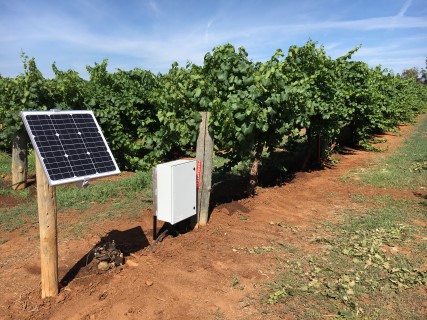 At Edaphic Scientific we want to work with you from the start of your project through to its completion. We can provide:
At Edaphic Scientific we want to work with you from the start of your project through to its completion. We can provide:
- Assistance with project and experimental design
- Procurement of all monitoring equipment, including sensors, data loggers and data management software. Edaphic Scientific is a one-stop shop where we can source and find any necessary equipment for your project from our preferred suppliers or third party suppliers
- Installation and training
- On-going assistance with data interpretation and equipment maintenance
- Data correction and analysis, including statistical analysis with the R-package
- Report and publication preparation including tables, figures, graphs, and manuscript writing
advanced data collection and management solutions
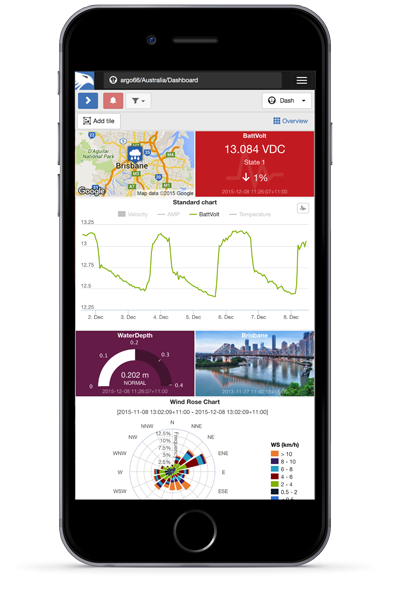 Edaphic Scientific recognises the need for flexible and adaptable sensor and data logging solutions for experimental or environmental monitoring projects.
Edaphic Scientific recognises the need for flexible and adaptable sensor and data logging solutions for experimental or environmental monitoring projects.
You can connect the HPV sap flow sensors to our data logging systems, or we can assist you in connecting the sap flow sensors to your existing system.
Data can be downloaded directly in the field from data loggers. Alternatively, data can be downloaded over the internet on your iPhone, iPad or desktop computer with the Eagle.io cloud-based, data management software solutions.
Edaphic Scientific provides sap flow sensors with:
Individual loggers or
Whole-System solutions with a centrally located data logger, multiplexers and additional equipment such as weather stations, soil moisture, water potential, carbon and nutrient monitoring.
Data can be collected directly from logging units with a USB download cable or remotely, anywhere in the world, via the mobile phone network and an internet connection.
individual data loggers
Edaphic Scientific supplies a one-to-one sap flow sensor to data logger monitoring solution.
The East 30 Sensors HPV sap flow sensors are compatible with Campbell Scientific's CR300 data logger for a low cost, individual data logging solution.
Edaphic Scientific provides both the sap flow sensor and pre-programmed, pre-configured CR300 data logger. Power supply is via a solar panel and 12V battery, and the data loggers are stored in an environmentally sealed protective housing.
The individual sap flow data loggers are ideal for:
- Urban tree monitoring: where security and safety for equipment is paramount. The data logger and power supply can be installed high and out of reach, or installed in underground pits. The cable for the sap flow sensors can be any length and sensors can be installed on any part of the tree trunk. If the sap flow sensors were damaged or vandalised, they can be quickly and cheaply replaced as they are low cost sensors.
- Remote tree monitoring: in remote locations, it may not be practical to have a single, centrally located data logging system with cables extended to various trees for sap flow monitoring. The individual sap flow data loggers are ideal in such projects.
- Horticulture and Viticulture: growers often require to run machinery and undertake other management procedures without worrying about tripping, cutting or damaging cabling and monitoring equipment. With a individual sap flow data logger, it is possible to undertake precision plant water use measurements on individual trees or vines without the need for extensive cabling and power supplies.
whole-system monitoring solutions
Edaphic Scientific can supply multiple sap flow sensors all connected to a single, centrally located data logging system, with multiplexers, power supply and environmentally protective housing.
Additional parameters can be added to the system for the monitoring of meteorological variables, soil moisture, water potential and soil carbon concentration.
Edaphic Scientific can supply a monitoring system that is completely pre-programmed, pre-configured and ready to be installed. We can also provide assistance with field installation and training of staff and students.
free software
A free Excel software package is provided with any purchase with all the sap flow calculations.
Why do you need software for sap flow measurements?
The Implexx Sap Flow Sensor outputs a calibrated calculation of total tree sap flow. Although this calibration output is an accurate estimation of sap flow, there are many researchers and scientists who prefer to analyse their own data or apply their own calibrations.
The Implexx Sap Flow Sensor also outputs heat velocity and raw temperature data. These parameters can subsequently be used for the calculation of heat velocity, sap flux density and sap flow.
The free Excel sap flow calculation package, provided by Implexx Sense, enables the researcher to perform these calculations. Every equation, and step, in the calculation process is clearly indicated. Therefore, the free Excel sap flow software package is ideal for researchers who want to delve further into the science and physics of sap flow.
sap flow sensor installation
Sap flow sensors are relatively easy to install in trees - particularly with some practice. Edaphic Scientific can provide training for you on correct approach to sap flow sensor installation.
Along with your sap flow sensors, we provide additional items for sensor installation including drill guide, drill bits and grafting wax.

